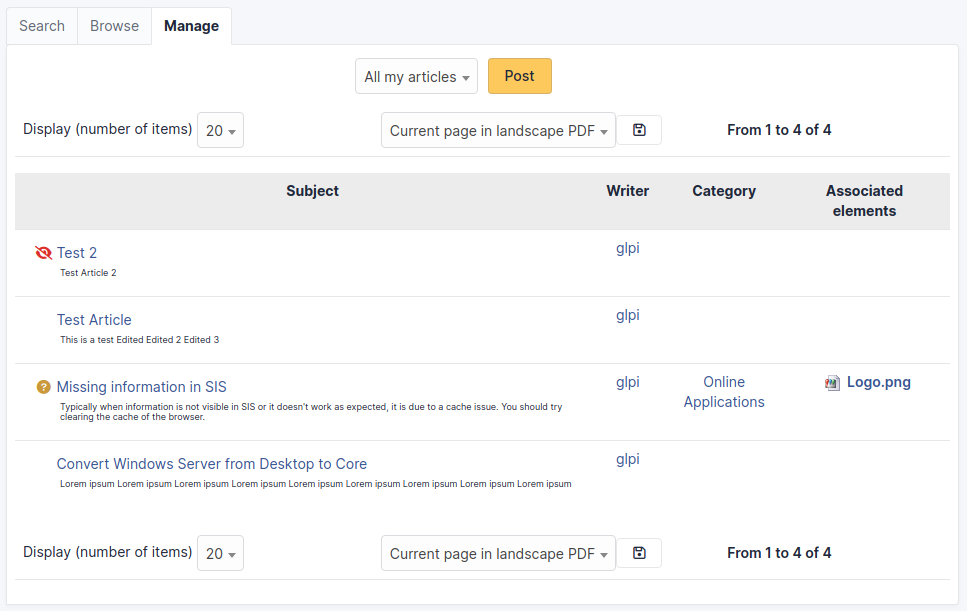Manage knowledge base¶
GLPI knowledge base has two main targets:
Gather internal knowledge for technicians;
Provide information as a public FAQ to enable users to solve simple problems on their own.
Note
Only public FAQ items are visible to users of simplified interface. Other elements are visible only to technicians via standard interface.
Each article of the knowledge base must have one or more targets, being entities, groups, profiles or users, to be readable. As long as an article has no target, it is visible only by its writer, is flagged as unpublished and appears in table Unpublished articles on the home page of the knowledge base.
Note
Modifié dans la version 10.1.
Targeting applies in the same way whether the article is in the FAQ or only in the knowledge base.
Note
You can publish an article for everyone by targeting the root entity.
By default, articles are not translatable. However, this functionality can be activated, see general configuration.
It is possible to attach documents to articles of the knowledge base.
Note
An article can be made visible during a time slot by defining a start date and an end date.
Avertissement
Elements which should not be interpreted when displayed can be defined with preformated style (<pre> in HTML). Tags like <VirtualHost> can therefore be inserted and will be displayed. Other HTML tags (<TAG>...</TAG> may disappear when editing; to have complete visibility of the text, it is possible to switch to HTML mode where all elements will be visible. The browser may also modify dynamically content (case change, tags adding) when editing.
It is possible to create categories and sub-categories in order to organize browsing (see Configure drop-downs). User can then use several tabs to search and browse knowledge base:
Search This tab is the default tab, displaying recent articles, popular articles and last changes. It allows also to search inside knowledge base.

Browse This tab allows to browse tree structure of categories.

Manage This tab is only visible for knowledge base administrators. Depending on user’s permissions, it is possible to access quickly user’s articles, user’s unpublished articles, all unpublished articles…

Note
The knowledge base search engine provides operators for complex search: + - ~ < > * ” ” ().
+: word must be there;-: word must not be there;*: truncate suffix;" ": contained sequence must be searched literally;< >: define order on search elements;(): group when using < and >.Examples : - printer failure -> Search lines containing at least one of these words - +printer +failure -> Search lines containing both words - +mail thunderbird -> Search lines containing word *mail* but rank higher lines containing also word *thunderbird* - +mail -outlook -> Search lines containing word *mail* but not word *outlook* - * +mail +(>thunderbird <outlook) -> Search lines containing word *mail* and *thunderbird*, or *mail* and *outlook*, in any order, but rank *mail thunderbird* higher than *mail outlook* - open* -> Search lines containing words such as *openoffice*, *openwriter*, *openbar*, *openphp*... - "openoffice suite" -> Search lines containing exactly sentence *openoffice suite*
The different tabs of an article¶
Knowledge base¶
This tab displays a table with article category, subject, content, writer, creation date, last modification date, number of views and FAQ membership.
If an article is unpublished (i.e. has no target), this information will appear in red above number of views.
Target¶
This tab allows to manage article’s targets.
An article is by default personal and therefore only visible by its creator.
For an article to become visible by other users, targets must be added to it, a target being either an entity, a group, a profile or a user who will be able to consult the article.
Edit¶
This tab allows, if appropriate permission, to modify or delete an article.
Associated elements¶
The Items tab is used to show or add linked assets.

Documents¶
Additional information is stored in the form of external documents which are files uploaded into GLPI. In the Documents tab, documents can be associated and unlinked with the selected item. The management of the documents themselves is dealt with in another chapter.
It is also possible to quickly create a document via this tab by specifying the desired file and optionally the field in which the new document is to be placed. The name of the created document will be based on the name of the added file.

Note
When you delete a document from this tab via mass actions, you only remove the link between the object and the document; the document itself is still present.
History¶
The History tab is used to show any changes made to an item. The following information about the changes is available:
ID of the change.
Date and time the change was made.
User who made the change. If this field is not filled, it means that the action was done automatically (For example: automatic inventory update).
Field that was changed.
Description of the change that was made.
The description of the change represents either the difference between the old and the new value (For example with location field: Change HQ to Remote Office A), or the explanation of the action which was carried out (For example: Uninstallation of a software: « Gimp 2.0 »).
Note
For dropdowns or objects with a parent/child relationship, the modification of a child will appear in the history of the parent element.
Revision¶
This tab allows to consult all article revisions: each saved modification of the article will create a revision storing the previous version of the article.
Revisions can be shown and restored.

All Information¶
For an item, all information is displayed on one page from the All tab. This shows all of the tabs of an object’s form in one view, one below the other.
Comments¶
This tab allows platform’s users to add their comments and discuss the article.